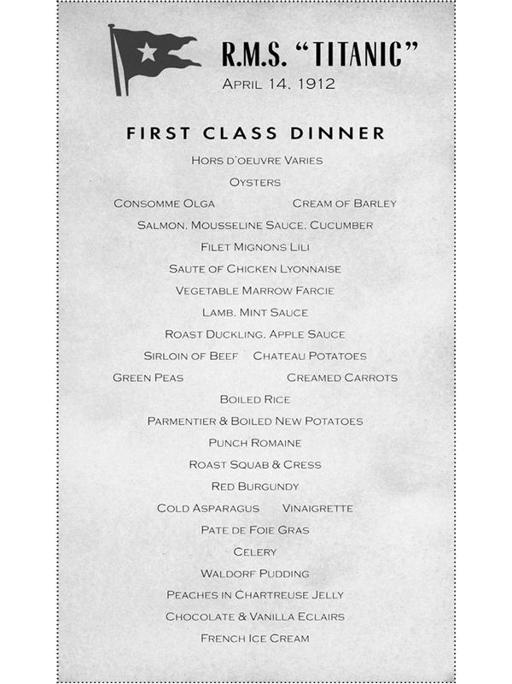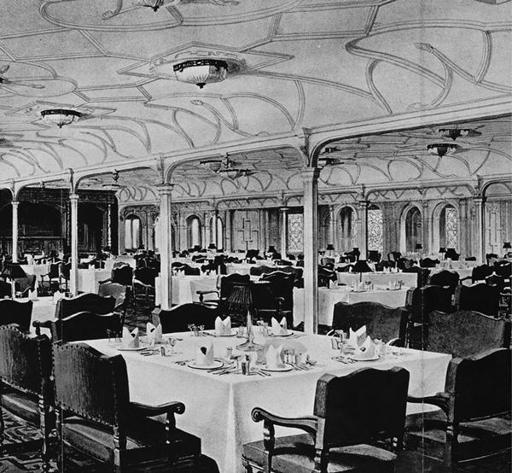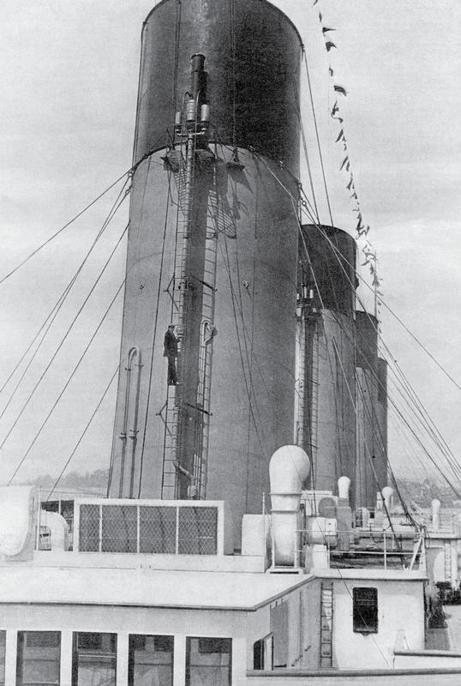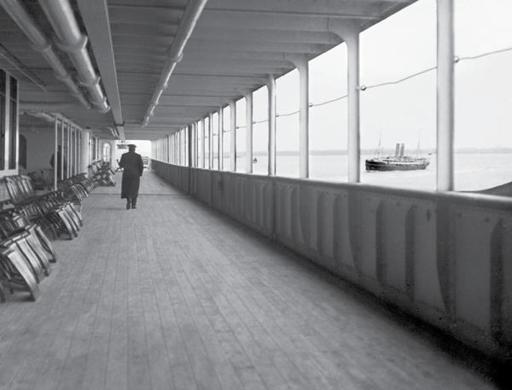Titanic (6 page)
Authors: Deborah Hopkinson

The
Titanic
has been described as several small towns — one for each class. It boasted an amazing array of food service options, from separate dining rooms for each class to several additional restaurants for first class passengers. The meals, especially in first class, rivaled the dinners in a fine restaurant onshore. First class passengers ate on bone china, some edged in twenty-two karat gold.
To reach the first class dining saloon, passengers could descend the grand staircase to a lovely reception room on D Deck, which served as a central meeting place and boasted tables as well as comfortable sofas and chairs. From this richly carpeted room, doors led into the dining room. This is where most first class passengers ate, since the cost of meals was included in their tickets.
The menu in the first class dining room was designed to cater to passengers accustomed to fine dining: People could enjoy such delicacies as oysters, poached salmon, roast duckling, lamb with mint sauce, and sirloin steak, with éclairs, pastries, or apple meringue for dessert.
(Preceding image)
First class passengers on White Star Line’s Olympic-class ships enjoyed luxurious dining experiences.
(Following image)
A first class dinner menu.

While the grown-ups enjoyed the meals, ocean views, and accommodations, nine-year-old Frankie Goldsmith, traveling in third class, was happy just to have an exciting new playground to explore.
Frankie’s family had been talking for months about going to America to join his aunt Eliza and her family, who lived near Detroit, Michigan. It had been a hard winter for Frankie and his parents. Frankie’s baby brother, Albert, had died of diphtheria just a few months before. Spring seemed the right time for a fresh start, and the young family made a fateful decision — they would leave their home and friends for a new life.
Frankie’s father had saved diligently for the voyage. On the day the
Titanic
set sail, Frankie and his parents, along with a friend, Thomas Theobald, took the train to London. There they picked up Alfred Rush, a teenager whom they’d promised to escort safely to friends in Detroit.
The traveling companions took the early boat train to Southampton with other second and third class passengers. Once on board the ship, a steward helped Frankie and his parents find their private third class cabin. Since most people traveled second and third class, these passengers were scheduled to arrive on board earlier to allow more time for families to find their cabins on D, E, F, or G deck; store their luggage; and settle crying babies.
If Frankie Goldsmith’s cabin was not as fancy as one in first or second class, he certainly wouldn’t have noticed. Frankie was too busy running around with his new friends, a gang of seven or eight boys around his own age.
Two of his friends were probably fellow third class passengers Rossmore and Eugene Abbott, ages sixteen and thirteen, returning to America with their mother, Rhoda, who became acquainted with Frankie’s mother on board.
Soon after leaving Ireland, the boys decided to try to climb up one of the cargo cranes used for lifting heavy items onto the ship, located on the Poop Deck, which was the third class promenade area in the stern. Of course Frankie went first. It would be like climbing trees back home. There was only one problem: When Frankie tried to grip the cable, he discovered it was covered in grease to protect it from the salty air.
Frankie hung on with all his might. It didn’t help that a group of sailors nearby burst into laughter at his predicament. It also didn’t help that his mother was
not
exactly happy at seeing his greasy hands and made him scrub them until at last they were clean — and probably bright red!
Third class passengers like Frankie and his friends were restricted to their own areas, partly by custom and also because of the separation of immigrants required by United States Immigration. But while there were clearly marked areas and evidence of gates, a researcher notes that “one myth that persists to this day is that of locked gates extending from floor-to-ceiling between the third class areas and the rest of the ship. It must be noted that there is no evidence, either documented or from the wreck, that any such barriers existed . . .”
But Frankie and his friends were less interested in fancy first class rooms than in wandering around E Deck. Here, doors from the boilers opened onto an alleyway called “Scotland Road,” the main walkway fore and aft used by third class passengers.
Frankie liked to watch the “black gang,” so called because their faces and arms were usually coated with coal dust. These were the firemen, trimmers, and greasers who worked in the
Titanic
’s six boiler rooms down in the Tank Top, where the ship’s twenty-nine massive boilers (each more than fifteen feet high) were located.
“We young boys also spent a lot of time peering down into the ship’s steam boiler rooms watching the stokers and firemen at work,” said Frankie. “. . . They were singing songs, often, while we looked down at them, some of them rattling their coal shovels on the grates of the coal burners . . .”
Greasers assisted in the engine room, oiling and greasing the turning equipment. Each fireman usually tended three furnaces, loading in the coal to keep the fires steady. (Firemen and stokers both shoveled coal, but according to leading stoker Frederick Barrett, the position of a stoker was considered more important, or “a little higher,” than a fireman.) Trimmers cooled the ash removed from the boilers with a hose. They also moved coal close to the boilers to keep the supply full. The boiler rooms were supervised by an engineer.
The black gang had to shovel all the coal by hand into the
Titanic’
s
159 furnaces, which consumed about 650 tons of coal a day. The coal-fired furnaces heated water in the boilers. This generated steam, which was forced into the engine to create the power needed to turn the propellers. The exhaust smoke vented through three of the
Titanic
’s gigantic funnels.
(Preceding image)
The immense funnels of a White Star Line’s Olympic-class ship.
These funnels stood over 60 feet above the Boat Deck. The distance from their tops down to the bottom of the keel was nearly three times that — 175 feet. The
Titani
c had four funnels: The fourth was used primarily for ventilation, but it definitely made the ship look more impressive.
Thanks to the hard work of the men of the black gang, the
Titanic
was making excellent time on her maiden voyage. The seas were calm and the sky clear. As the morning of Sunday, April 14, dawned, it seemed certain that the magnificent ship would have no trouble making New York harbor by Wednesday morning — right on schedule.
(Preceding image)
The Promenade Deck.





